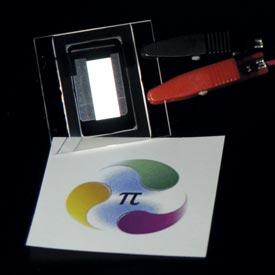

06/27/2016

2015 © The Authors. From Ref. 1. This work is licensed under CC BY-NC 3.0
A ring-shaped molecule can play multiple roles in an organic light-emitting diode (OLED)1. This finding by AIMR researchers could simplify the manufacture of these devices without reducing their performance.
OLEDs contain a layer of carbon-based molecules that emit light when an electric current passes through them. They have many advantages, including being thin, light and potentially flexible, as well as consuming relatively little energy. They are thus being increasingly used in electronic devices like mobile phones and displays.
Many OLEDs contain multiple layers of different materials, each of which performs a specific function. For example, one layer carries negative electrons, while another transports positive holes — the gaps left by missing electrons. When electrons and holes meet, they bind to produce a high-energy ‘exciton’ state. Some OLEDs use a phosphorescent material that converts excitons into light; this requires yet another layer to prevent electrons or holes escaping from the phosphorescent emitter.
Hiroyuki Isobe of the AIMR at Tohoku University and co-workers have studied a family of molecules that can perform most of these tasks in a single layer, potentially allowing for much easier fabrication of OLEDs. These molecules, known as cyclo-meta-phenylenes (CMPs), are based on a large ring consisting of five or six benzene molecules.
The team tested these ring-shaped molecules in combination with a common phosphorescent emitter. Several of them were “completely useless”, says Isobe. But one of them, a ring of five substituted benzenes called 5Me-[5]CMP, far exceeded expectations.
It could transport electrons and holes, provide a place for them to form excitons and pass excitons on to the phosphorescent emitter. Crucially, it also slowed holes down so they could not escape, ensuring their complete conversion to light. Consequently, this OLED had an external quantum efficiency of up to about 23 per cent — almost as good as the best single-layer OLED and comparable with those of multilayer OLEDs. One reason for this high efficiency is that the 5Me-[5]CMP is a flexible molecule that can get very close to the iridium-based emitter to pass on excitons.
The team then blended 5Me-[5]CMP with red, blue and green emitters to make a white-light OLED, which had an efficiency of about 10 per cent (see image). “This is still a very premature demonstration, because the device architecture was not optimized,” notes Isobe.
The team is improving the chemical synthesis of the CMPs to create molecules that reach even higher device efficiencies. Isobe adds: “AIMR is an ideal place for such interdisciplinary investigations.”
This research highlight has been approved by the authors of the original article and all information and data contained within has been provided by said authors.